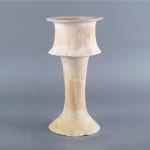Bactrian Alabaster Vessel, 2500 to 1000 BCE
Alabaster
37.6 x 19.2 cm
14 3/4 x 7 1/2 in
14 3/4 x 7 1/2 in
CB.3381
Further images
This outstanding alabaster vessel dates to one of the period of peak refinement in Bactrian history. It is very finely carved, with the surface most carefully smoothed. It is more...
This outstanding alabaster vessel dates to one of the period of peak refinement in Bactrian history. It is very finely carved, with the surface most carefully smoothed. It is more than probable that such a precious item had a ritual function. Its delicate colour and great refinement make this vessel an artefact of great cultural interest and of incredible aesthetic value.
Bactria or Bactriana was the name of a historical region in Central Asia. Bactria was located between the Hindu Kush mountain and the Amu Darya river, covering the flat region that straddles modern-day Afghanistan, Tajikistan, and Uzbekistan. The English name of Bactria derives from the Ancient Greek. Bactria, the territory of which Bactra was the capital, originally consisted of the area south of the Amu Darya with its string of agricultural oases dependent on water taken from the adjacent rivers. This region played a major role in Central Asian history. At certain times the political limits of Bactria stretched far beyond the geographic frame of the Bactrian plain.
The Bactria–Margiana Archaeological Complex (BMAC, also known as the "Oxus civilization") is the modern archaeological designation for a Bronze Age culture of Central Asia, dated to ca. 2200–1700 BC, located in present-day eastern Turkmenistan, northern Afghanistan, southern Uzbekistan and western Tajikistan, centred on the upper Amu Darya (Oxus River), an area covering ancient Bactria. Its sites were discovered and named by the Soviet archaeologist Viktor Sarianidi (1976). Bactria was the Greek name for Old Persian Baxtriš (from native *Baxçiš) (named for its capital Bactra, modern Balkh), in what is now northern Afghanistan, and Margiana was the Greek name for the Persian satrapy of Margu, the capital of which was Merv, in today's Turkmenistan. The early Greek historian Ctesias, c. 400 BC (followed by Diodorus Siculus), alleged that the legendary Assyrian king Ninus had defeated a Bactrian king named Oxyartes in ca. 2140 BC, or some 1000 years before the Trojan War. Since the decipherment of cuneiform in the 19th century, however, which enabled actual Assyrian records to be read, historians have ascribed little value to the Greek account.
Bactria or Bactriana was the name of a historical region in Central Asia. Bactria was located between the Hindu Kush mountain and the Amu Darya river, covering the flat region that straddles modern-day Afghanistan, Tajikistan, and Uzbekistan. The English name of Bactria derives from the Ancient Greek. Bactria, the territory of which Bactra was the capital, originally consisted of the area south of the Amu Darya with its string of agricultural oases dependent on water taken from the adjacent rivers. This region played a major role in Central Asian history. At certain times the political limits of Bactria stretched far beyond the geographic frame of the Bactrian plain.
The Bactria–Margiana Archaeological Complex (BMAC, also known as the "Oxus civilization") is the modern archaeological designation for a Bronze Age culture of Central Asia, dated to ca. 2200–1700 BC, located in present-day eastern Turkmenistan, northern Afghanistan, southern Uzbekistan and western Tajikistan, centred on the upper Amu Darya (Oxus River), an area covering ancient Bactria. Its sites were discovered and named by the Soviet archaeologist Viktor Sarianidi (1976). Bactria was the Greek name for Old Persian Baxtriš (from native *Baxçiš) (named for its capital Bactra, modern Balkh), in what is now northern Afghanistan, and Margiana was the Greek name for the Persian satrapy of Margu, the capital of which was Merv, in today's Turkmenistan. The early Greek historian Ctesias, c. 400 BC (followed by Diodorus Siculus), alleged that the legendary Assyrian king Ninus had defeated a Bactrian king named Oxyartes in ca. 2140 BC, or some 1000 years before the Trojan War. Since the decipherment of cuneiform in the 19th century, however, which enabled actual Assyrian records to be read, historians have ascribed little value to the Greek account.







